High-Surface-Area ZIF-67 Nanoflowers: Synthesis and Application Toward Enhanced CH4/N2 Separation in Mixed Matrix Membranes
Abstract
1. Introduction
2. Materials and Methods
2.1. Computational Details
2.2. Materials
2.3. Synthesis of 2D Nanoflower ZIF-67 (ZIF-67nf)
2.4. Preparation of MMMs
2.5. Characterization
3. Results and Discussion
3.1. Aggregation and Reactivity
3.2. SEM, XRD and BET
3.3. MMMs Performance
4. Conclusions
Funding
Institutional Review Board Statement
Informed Consent Statement
Data Availability Statement
Conflicts of Interest
References
- IEA. Methane from Oil & Gas-Methane Tracker 2021-Analysis; IEA: Paris, France, 2021; Available online: https://www.iea.org/fuels-and-technologies/methane-abatement (accessed on 7 December 2021).
- Wang, Q.; Yu, Y.; Li, Y.; Min, X.; Zhang, J.; Sun, T. Methane separation and capture from nitrogen rich gases by selective adsorption in microporous Materials: A review. Sep. Purif. Technol. 2021, 283, 120206. [Google Scholar] [CrossRef]
- Zhang, C.; Chen, Y.; Wu, H.; Li, H.; Li, X.; Tu, S.; Qiao, Z.; An, D.; Xia, Q. Mechanochemical synthesis of a robust cobalt-based metal–organic framework for ads;orption separation methane from nitrogen. Chem. Eng. J. 2021, 435, 133876. [Google Scholar] [CrossRef]
- Winarta, J.; Meshram, A.; Zhu, F.; Li, R.; Jafar, H.; Parmar, K.; Liu, J.; Mu, B. Metal-organic framework-based mixed-matrix membranes for gas separation: An overview. J. Polym. Sci. 2020, 58, 2518–2546. [Google Scholar] [CrossRef]
- Foo, K.; Liang, Y.Y.; Goh, P.S.; Fletcher, D.F. Computational fluid dynamics simulations of membrane gas separation: Overview, challenges and future perspectives. Process Saf. Environ. Prot. 2023, 191, 127–140. [Google Scholar] [CrossRef]
- Elahi, F.; Wang, Y.; Hazazi, K.; Kumar, V.; Balcik, M.; Wehbe, N.; Xu, F.; Pinnau, I. Long-term pure- and mixed-gas performance of carbon molecular sieve membranes derived from a tetraphenylethylene-based ladder polymer of intrinsic microporosity (TPE-PIM) for propylene/propane separation. J. Membr. Sci. 2024, 713, 123255. [Google Scholar] [CrossRef]
- Li, B.; Qi, B.; Han, J.; Qian, X.; Yang, C.; Cai, S. Separation of oil–water emulsion by biomimetic polycaprolactone tannic acid hydrophilic modified membranes. Fuel 2025, 386, 134242. [Google Scholar] [CrossRef]
- He, S.; Zhu, B.; Li, S.; Zhang, Y.; Jiang, X.; Lau, C.H.; Shao, L. Recent progress in PIM-1 based membranes for sustainable CO2 separations: Polymer structure manipulation and mixed matrix membrane design. Sep. Purif. Technol. 2022, 284, 120277. [Google Scholar] [CrossRef]
- Rodenas, T.; Luz, I.; Prieto, G.; Seoane, B.; Miro, H.; Corma, A.; Kapteijn, F.; Llabrés, I.; Xamena, F.X.; Gascon, J. Metal-organic framework nanosheets in polymer composite materials for gas separation. Nat. Mater. 2014, 14, 48–55. [Google Scholar] [CrossRef]
- Zhang, J.; Dong, H.; Guo, F.; Yi, H.; Jiang, X.; He, G.; Xiao, W. Construction of Transport Channels by HNTs@ZIF-67 Composites in a Mixed-Matrix Membrane for He/CH4 Separation. Membranes 2025, 15, 197. [Google Scholar] [CrossRef]
- Jonnalagedda, A.; Choudhari, S.A.; Nayak, B.; Pani, A.K.; Kuncharam, B.V.R. Asymmetric mixed matrix membranes with zeolite imidazolate frameworks (ZIF-8, ZIF-67, bimetallic ZIF-8/67) and polyethersulfone for high flux and high selective hydrogen separation. Polym. Eng. Sci. 2025, 65, 3209–3225. [Google Scholar] [CrossRef]
- Missaoui, N.; Chrouda, A.; Kahri, H.; Gross, A.J.; Ardani, M.R.; Pang, A.L.; Ahmadipour, M. PEG-templated synthesis of ultramicroporous n-ZIF-67 nanoparticles with high selectivity for the adsorption and uptake of CO2 over CH4 and N2. Sep. Purif. Technol. 2023, 316, 123755. [Google Scholar] [CrossRef]
- Kim, S.; Shamsaei, E.; Lin, X.; Hu, Y.; Simon, G.P.; Seong, J.G.; Kim, J.S.; Lee, W.H.; Lee, Y.M.; Wang, H. The enhanced hydrogen separation performance of mixed matrix membranes by incorporation of two-dimensional ZIF-L into polyimide containing hydroxyl group. J. Membr. Sci. 2017, 549, 260–266. [Google Scholar] [CrossRef]
- Zhu, W.; Li, X.; Sun, Y.; Guo, R.; Ding, S. Introducing hydrophilic ultra-thin ZIF-L into mixed matrix membranes for CO2/CH4 separation. RSC Adv. 2019, 9, 23390–23399. [Google Scholar] [CrossRef]
- Datta, S.J.; Mayoral, A.; Bettahalli, N.M.S.; Bhatt, P.M.; Karunakaran, M.; Carja, I.D.; Fan, D.; Mileo, P.G.M.; Semino, R.; Maurin, G.; et al. Rational design of mixed-matrix metal-organic framework membranes for molecular separations. Science 2022, 376, 1080–1087. [Google Scholar] [CrossRef]
- Zhao, Q.; Lian, S.; Li, R.; Yang, Y.; Zang, G.; Song, C. Fabricating Leaf-like hierarchical ZIF-67 as Intra-Mixed matrix membrane microarchitecture for efficient intensification of CO2 separation. Sep. Purif. Technol. 2022, 305, 122460. [Google Scholar] [CrossRef]
- Zhu, C.; Peng, Y.; Li, K.; Liu, L.; Yang, W. Regulation of MOF-74 Nanosheet Channels for Precise H2 Purification. J. Membr. Sci. 2024, 709, 123140. [Google Scholar] [CrossRef]
- Liu, X.; Chee, S.W.; Raj, S.; Sawczyk, M.; Král, P.; Mirsaidov, U. Three-step nucleation of metal-organic framework nanocrystals. Proc. Natl. Acad. Sci. USA 2021, 118, e2008880118. [Google Scholar] [CrossRef]
- Frisch, M.J.; Trucks, G.W.; Schlegel, H.B.; Scuseria, G.E.; Robb, M.A.; Cheeseman, J.R.; Scalmani, G.; Barone, V.; Petersson, G.A.; Nakatsuji, H.; et al. Gaussian, 1.6. Revision, A.0.3; Gaussian, Inc.: Wallingford, CT, USA, 2016. [Google Scholar]
- Adamo, C.; Barone, V. Toward reliable density functional methods without adjustable parameters: The PBE0 model. J. Chem. Phys. 1999, 110, 6158–6170. [Google Scholar] [CrossRef]
- Krishnan, R.; Binkley, J.S.; Seeger, R.; Pople, J.A. Self-consistent molecular orbital methods. XX. A basis set for correlated wave functions. J. Chem. Phys. 1980, 72, 650–654. [Google Scholar] [CrossRef]
- Mennucci, B.; Tomasi, J. Continuum solvation models: A new approach to the problem of solute’s charge distribution and cavity boundaries. J. Chem. Phys. 1997, 106, 5151–5158. [Google Scholar] [CrossRef]
- Kozuch, S.; Martin, J.M.L. DSD-PBEP86. In search of the best double-hybrid DFT with spin-component scaled MP2 and dispersion corrections. Phys. Chem. Chem. Phys. 2011, 13, 20104. [Google Scholar] [CrossRef]
- Weigend, F.; Ahlrichs, R. Balanced basis sets of split valence, triple zeta valence and quadruple zeta valence quality for H to Rn: Design and assessment of accuracy. Phys. Chem. Chem. Phys. 2005, 7, 3297. [Google Scholar] [CrossRef]
- Marenich, A.V.; Cramer, C.J.; Truhlar, D.G. Universal Solvation Model Based on Solute Electron Density and on a Continuum Model of the Solvent Defined by the Bulk Dielectric Constant and Atomic Surface Tensions. J. Phys. Chem. B 2009, 113, 6378–6396. [Google Scholar] [CrossRef]
- Lu, T.; Chen, F. Multiwfn: A multifunctional wavefunction analyzer. J. Comput. Chem. 2011, 33, 580–592. [Google Scholar] [CrossRef]
- Humphrey, W.; Dalke, A.; Schulten, K. VMD: Visual molecular dynamics. J. Mol. Graph. 1996, 14, 33–38. [Google Scholar] [CrossRef] [PubMed]
- Li, B.; Guo, Z.; Zheng, L.; Du, M.; Han, J.; Yang, C. Effect of modified EVA-GMX bionic nanocomposite pour point depressants on the rheological properties of waxy crude oil. Fuel 2025, 403, 136025. [Google Scholar] [CrossRef]
- Perez, E.V.; Balkus, K.J.; Ferraris, J.P.; Musselman, I.H. Mixed-matrix membranes containing MOF-5 for gas separations. J. Membr. Sci. 2009, 328, 165–173. [Google Scholar] [CrossRef]
- Perez, E.V.; Balkus, K.J.; Ferraris, J.P.; Musselman, I.H. Metal-organic polyhedra 18 mixed-matrix membranes for gas separation. J. Membr. Sci. 2014, 463, 82–93. [Google Scholar] [CrossRef]
- Wang, S.; Guo, Q.; Liang, S.; Li, P.; Li, X.; Luo, J. [Ni3(HCOO)6]/Poly(styrene-b-butadiene-b-styrene) Mixed-Matrix Membranes for CH4/N2 Gas Separation. Chem. Eng. Technol. 2017, 41, 353–366. [Google Scholar] [CrossRef]
- Wang, S.; Guo, Q.; Liang, S.; Li, P.; Luo, J. Preparation of Ni-MOF-74/SBS mixed matrix membranes and its application of CH4/N2 separation. Sep. Purif. Technol. 2018, 199, 206–213. [Google Scholar] [CrossRef]
- Chi, W.S.; Hwang, S.; Lee, S.-J.; Park, S.; Bae, Y.-S.; Ryu, D.Y.; Kim, J.H.; Kim, J. Mixed matrix membranes consisting of SEBS block copolymers and size-controlled ZIF-8 nanoparticles for CO2 capture. J. Membr. Sci. 2015, 495, 479–488. [Google Scholar] [CrossRef]
- Miri, S.; Omidkhah, M.; Ebadi Amooghin, A.; Matsuura, T. Membrane-based gas separation accelerated by quaternary mixed matrix membranes. J. Nat. Gas Sci. Eng. 2020, 84, 103655. [Google Scholar] [CrossRef]
- Estahbanati, E.G.; Omidkhah, M.; Amooghin, A.E. Interfacial Design of Ternary Mixed Matrix Membranes Containing Pebax 1657/Silver-Nanopowder/[BMIM][BF4] for Improved CO2 Separation Performance. ACS Appl. Mater. Interfaces 2017, 9, 10094–10105. [Google Scholar] [CrossRef] [PubMed]

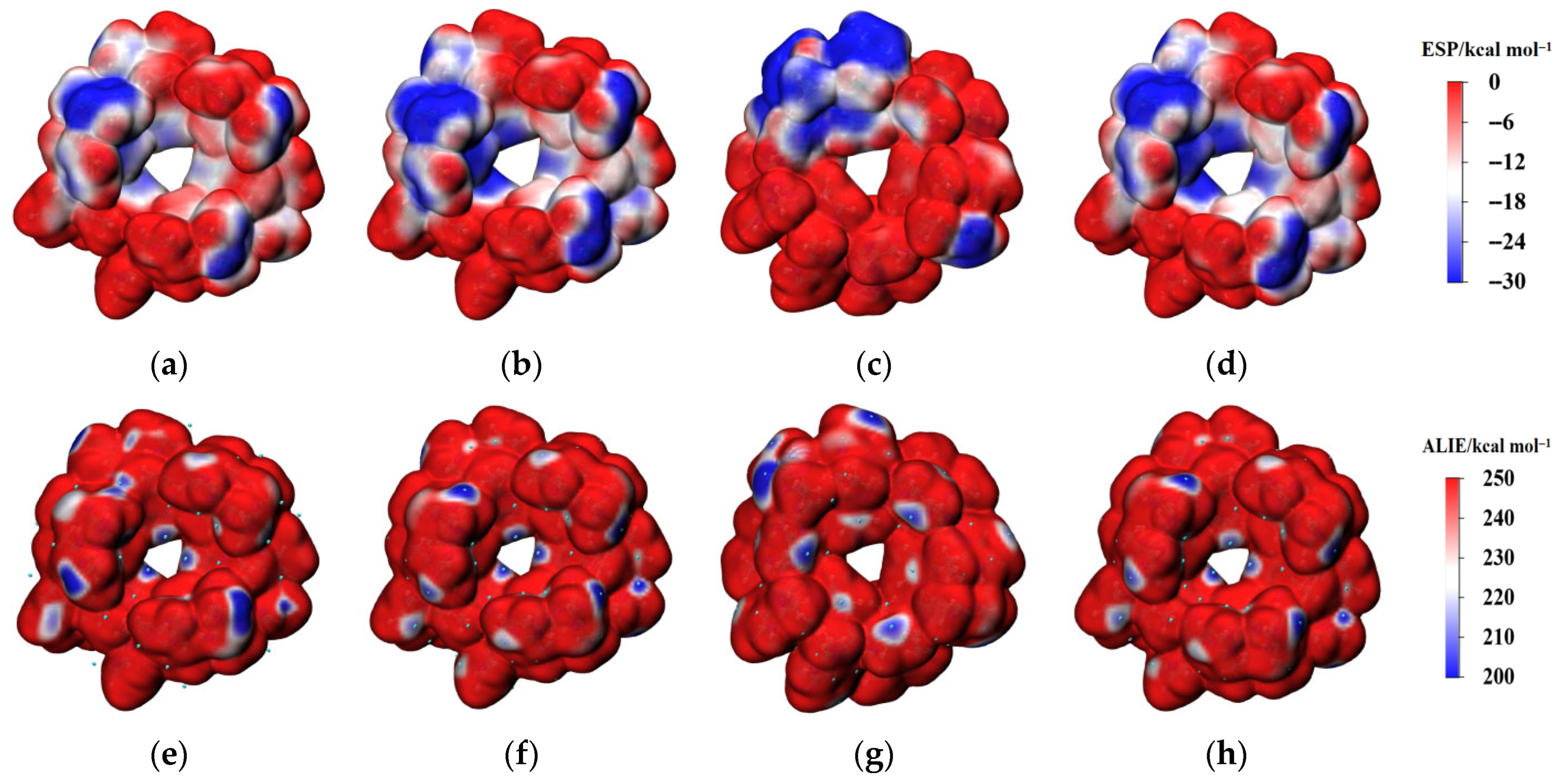


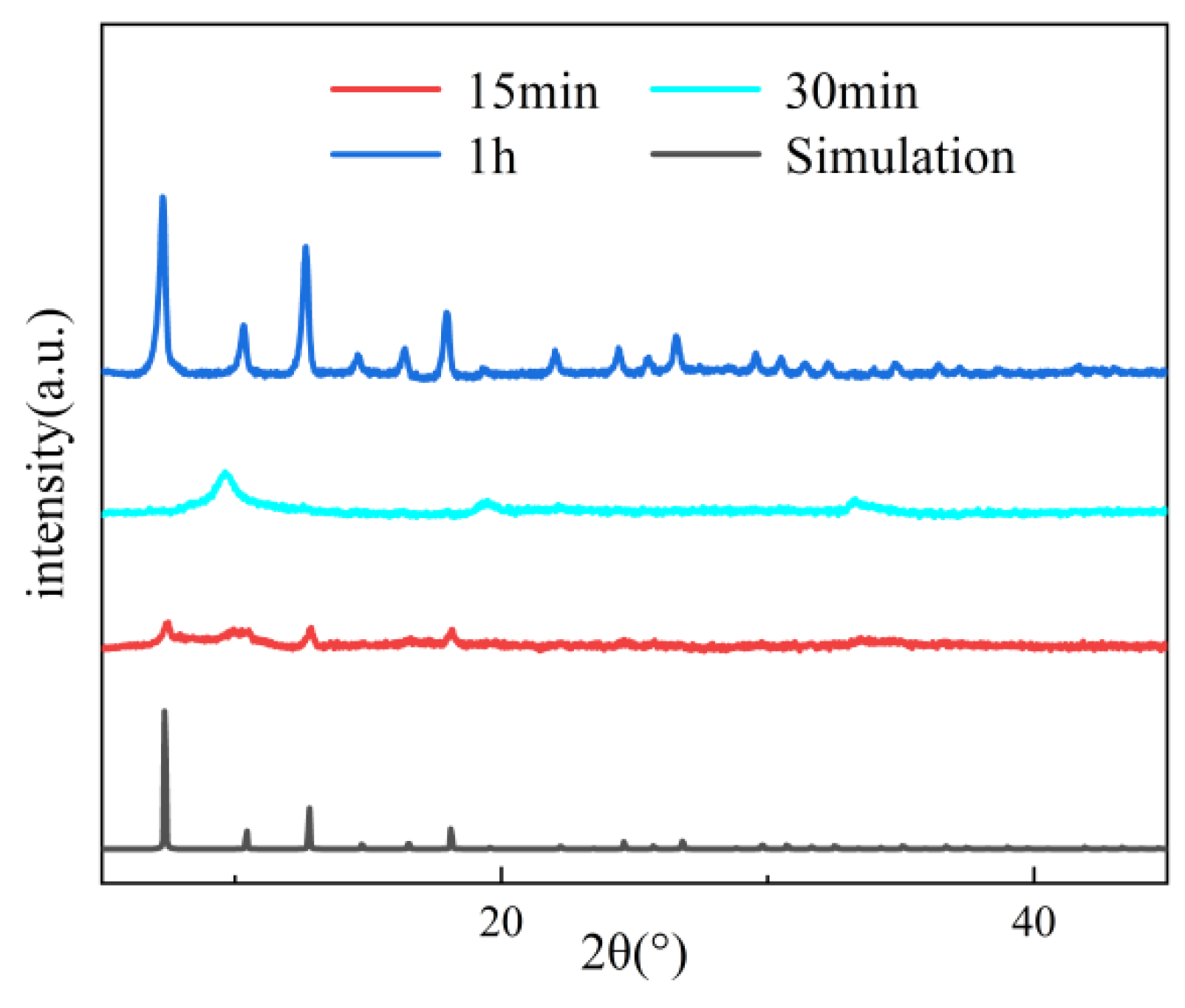
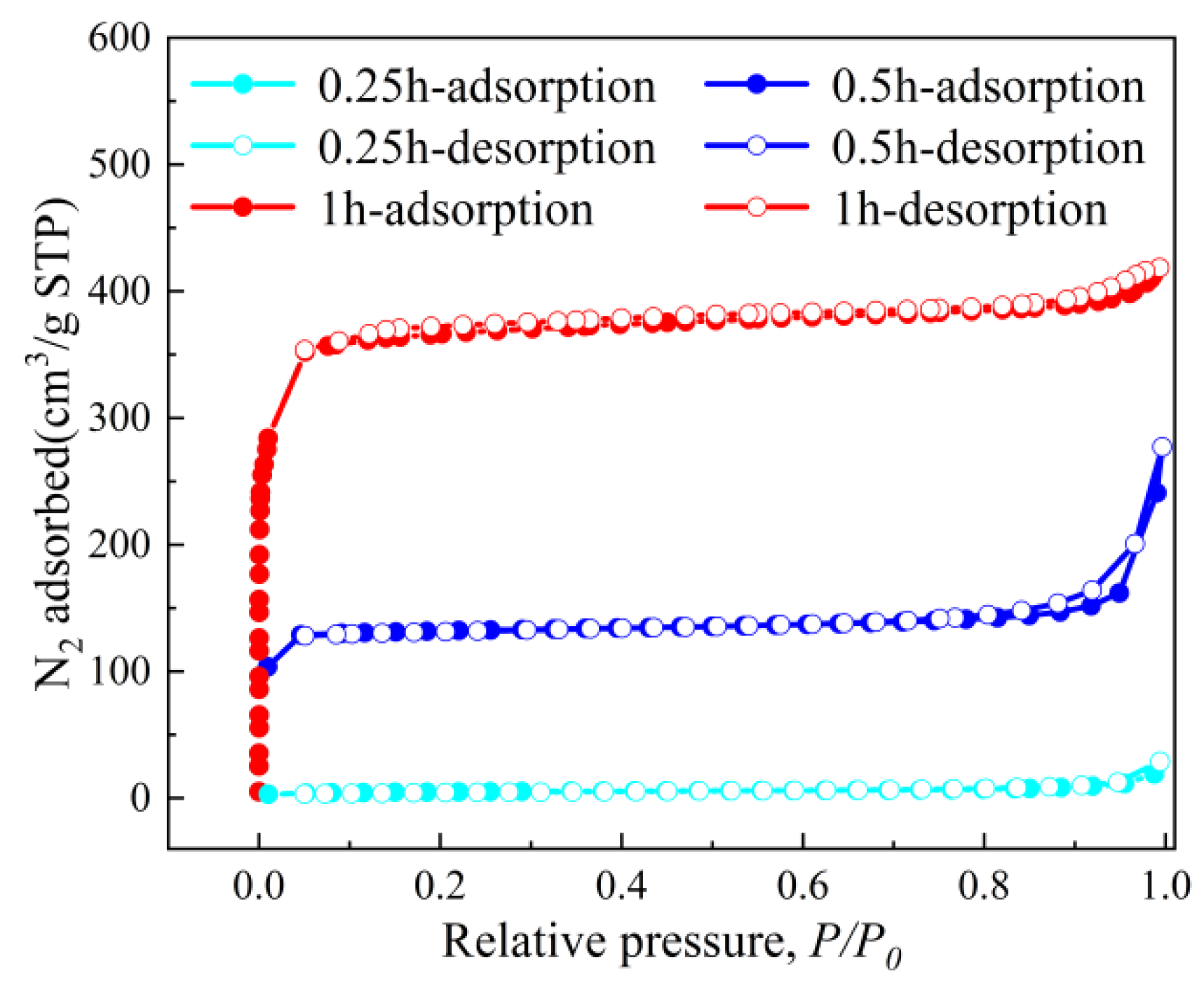




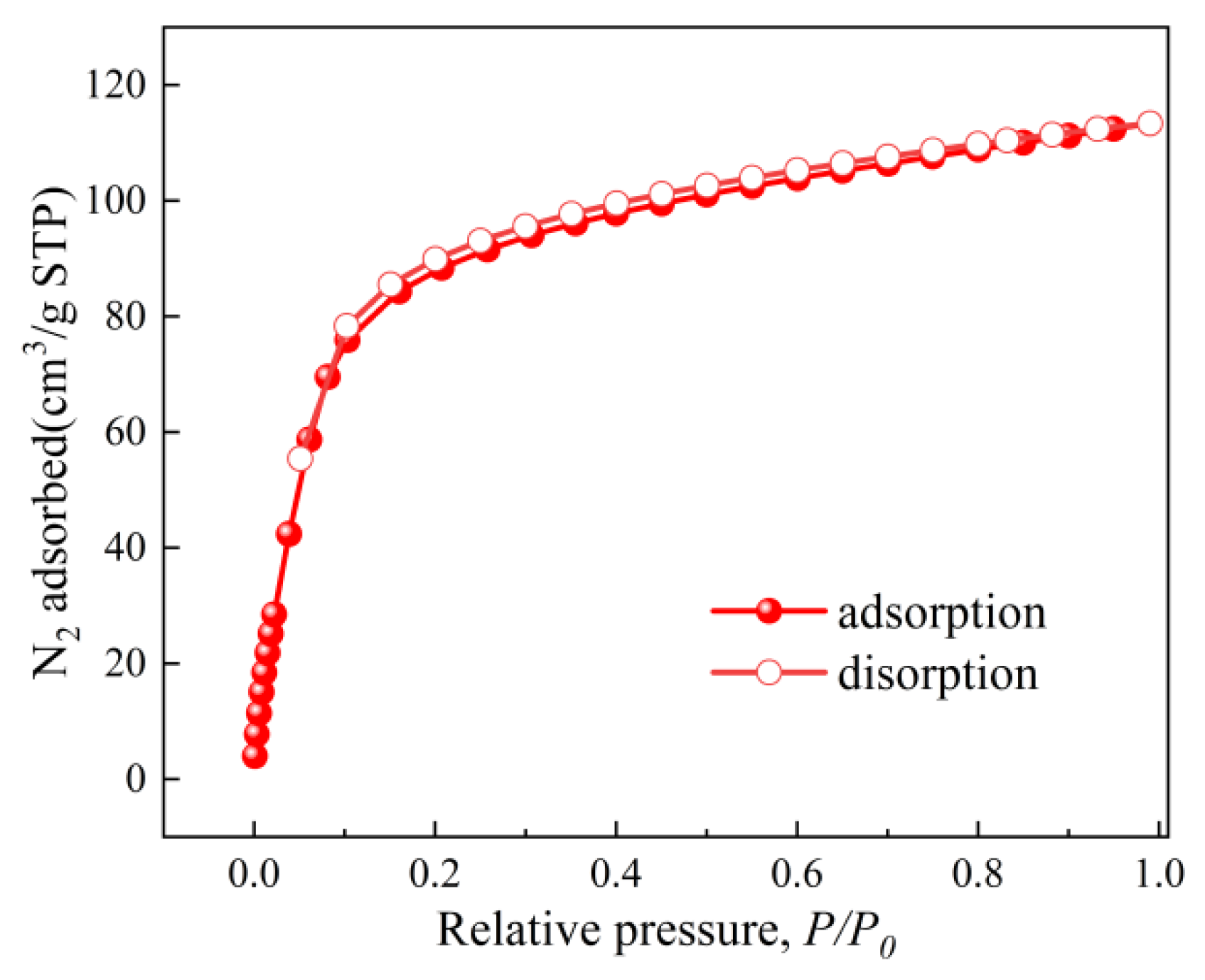

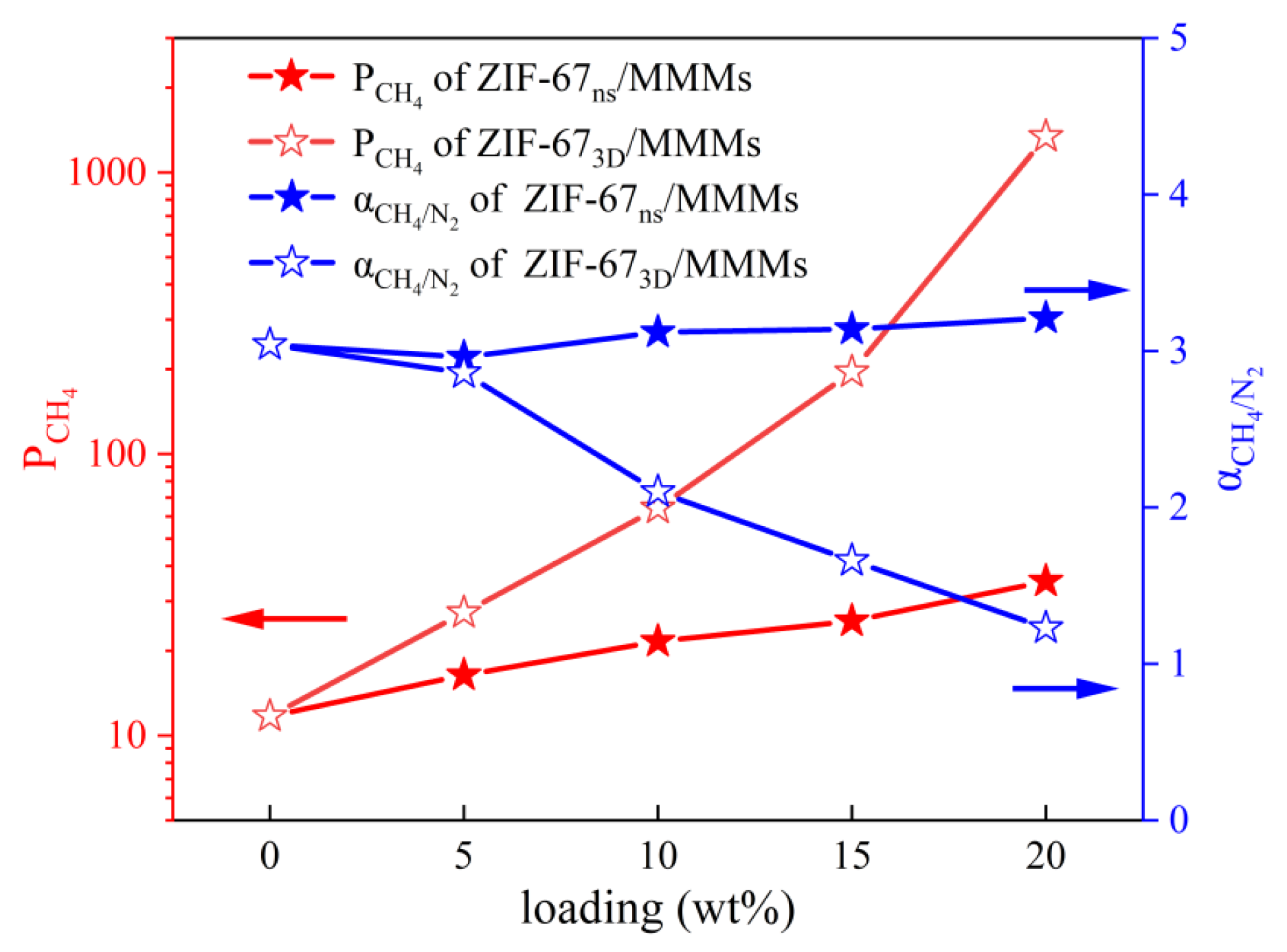
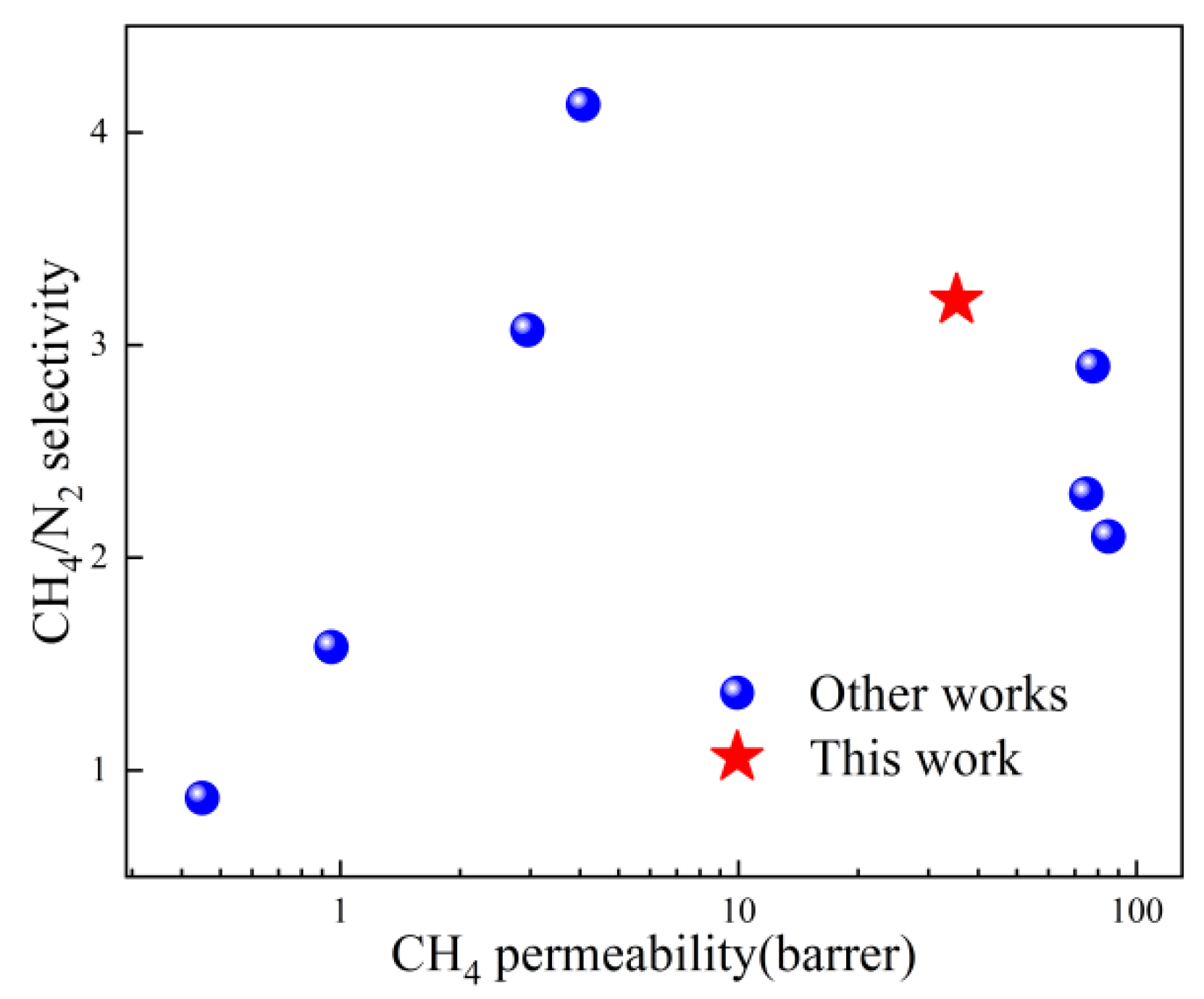
| MMMs | Solvent | Temperature | Permeability (Barrer) | CH4/N2 Selectivity | |
|---|---|---|---|---|---|
| CH4 | N2 | ||||
| Matrimid®/MOF-5 [29] | chloroform | RT | 0.45 | 0.52 | 0.87 |
| Matrimid® 5218/MOP-18 [30] | chloroform | 0.95 | 0.60 | 1.58 | |
| SBS/[Ni3(HCOO)6] [31] | Tetrahydrofuran | 77.7 | 26.7 | 2.9 | |
| SBS/Ni-MOF-74 [32] | Tetrahydrofuran | 74.7 | 32.2 | 2.3 | |
| SEBS/ZIF-8 [33] | Tetrahydrofuran | 84.9 | 41.2 | 2.1 | |
| Pebax@1657/glycerol/PEG200/NiFe2O4 [34] | 1-butanol | 80 °C | 4.07 | 0.98 | 4.13 |
| Pebax1657/Ag/[BMIM][BF4] [35] | 1-butanol | 110 °C | 2.95 | 0.96 | 3.07 |
| SEBS/ZIF-67nf (this work) | toluene | RT | 35.3 | 11.0 | 3.21 |
Disclaimer/Publisher’s Note: The statements, opinions and data contained in all publications are solely those of the individual author(s) and contributor(s) and not of MDPI and/or the editor(s). MDPI and/or the editor(s) disclaim responsibility for any injury to people or property resulting from any ideas, methods, instructions or products referred to in the content. |
© 2025 by the author. Licensee MDPI, Basel, Switzerland. This article is an open access article distributed under the terms and conditions of the Creative Commons Attribution (CC BY) license (https://creativecommons.org/licenses/by/4.0/).
Share and Cite
Li, D. High-Surface-Area ZIF-67 Nanoflowers: Synthesis and Application Toward Enhanced CH4/N2 Separation in Mixed Matrix Membranes. Coatings 2025, 15, 987. https://doi.org/10.3390/coatings15090987
Li D. High-Surface-Area ZIF-67 Nanoflowers: Synthesis and Application Toward Enhanced CH4/N2 Separation in Mixed Matrix Membranes. Coatings. 2025; 15(9):987. https://doi.org/10.3390/coatings15090987
Chicago/Turabian StyleLi, Dongze. 2025. "High-Surface-Area ZIF-67 Nanoflowers: Synthesis and Application Toward Enhanced CH4/N2 Separation in Mixed Matrix Membranes" Coatings 15, no. 9: 987. https://doi.org/10.3390/coatings15090987
APA StyleLi, D. (2025). High-Surface-Area ZIF-67 Nanoflowers: Synthesis and Application Toward Enhanced CH4/N2 Separation in Mixed Matrix Membranes. Coatings, 15(9), 987. https://doi.org/10.3390/coatings15090987





